Utah is one of the most stunning states to explore in the USA that’s full of natural landmarks. From towering sandstone spires to thousands of naturally eroded arches to desolate salt flats that resemble a moonscape, Utah is the perfect destination for nature lovers. Utah is a state with impressive landmarks, including many natural landmarks within its five national parks.
Utah is also famous for skiing, and the mountains near Salt Lake City receive around 500 inches of snow each year. While in Utah, Salt Lake City is a treasure trove of historic landmarks built in the 19th century when the Mormons settled here. With a long list of famous natural landmarks in Utah to tick off your list, there’s plenty to add to your bucket list.
Contents
- 20 Utah Landmarks
- 1- Delicate Arch
- 2- Bonneville Salt Flats
- 3- The Hoodoos
- 4- Big Bend
- 5- Chimney Rock Pillar
- 6- Coyote Gulch
- 7- Factory Butte
- 8- Flaming Gorge
- 9- Golden Cathedral
- 10- House of Fire
- 11- Hovenweep Castle
- 12- Rainbow Bridge
- 13- Reflection Canyon
- 14- Buckskin Gulch
- 15- The Hoodoos in Goblin Valley State Park
- 16- Virgin River
- 17- Timpanogos Cave National Monument
- 18- Cosmic Naval
- 19- Valley of the Gods
- 20- Monument Valley
20 Utah Landmarks
1- Delicate Arch
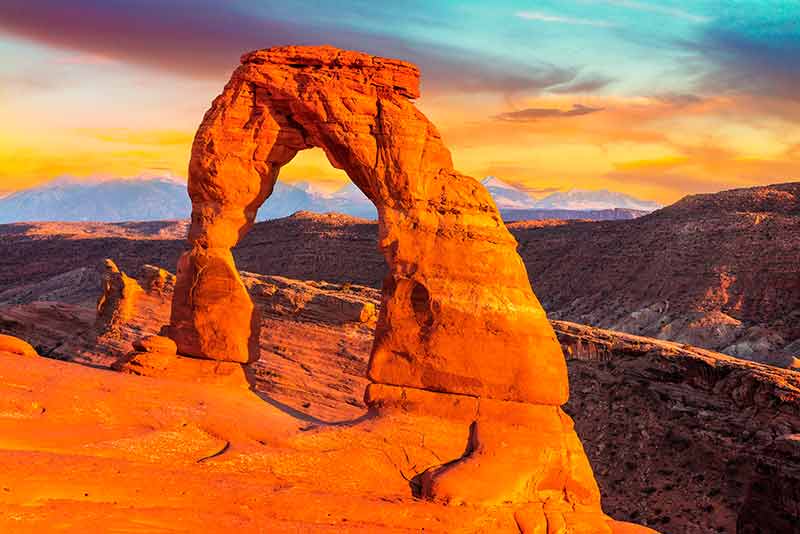
Delicate Arch is a 52 ft (16 m) natural arch that is one of the most famous landmarks in Utah.
With a soaring 46ft tall opening, it’s also the park’s largest free-standing arch and was named ‘delicate’ when the Arches National Monument Scientific Expedition described it as the most delicately chiselled arch in the area in 1934.
The trek to explore Delicate Arch is a three-mile (4.8 km) uphill roundtrip that climbs to 480 feet (146m), passing some interesting monuments such as a wall of Ute Indian petroglyphs and Wolfe Ranch cabin.
Arches National Park is one of Utah’s most stunning national parks and home to over 2,000 natural sandstone arches.
Activities in the park include canyoneering, hiking, climbing and horse riding.
Delicate Arch is in Arches National Park, Moab, Utah.
2- Bonneville Salt Flats
In northwest Utah, Bonneville Salt Flats is a salt pan and the largest salt flat west of the Great Salt Lake.
The otherworldly landmark in Utah is perfectly flat and covers 30,000 acres with a layer of salty soil that resembles snow.
No plants can grow in this salt-laden soil, made of around 90% common table salt, with a crust almost five feet deep near the centre.
Bonneville is listed on the National Register of Historic Landmarks for its contribution to land speed racing.
The Bonneville Speedway near Wendover occupies the western section of the salt flats.
The 12 by five-mile salt flats contain around 99 million cubic yards of salt!
Bonneville Salt Flats can be visited as a day trip from Salt Lake City.
3- The Hoodoos
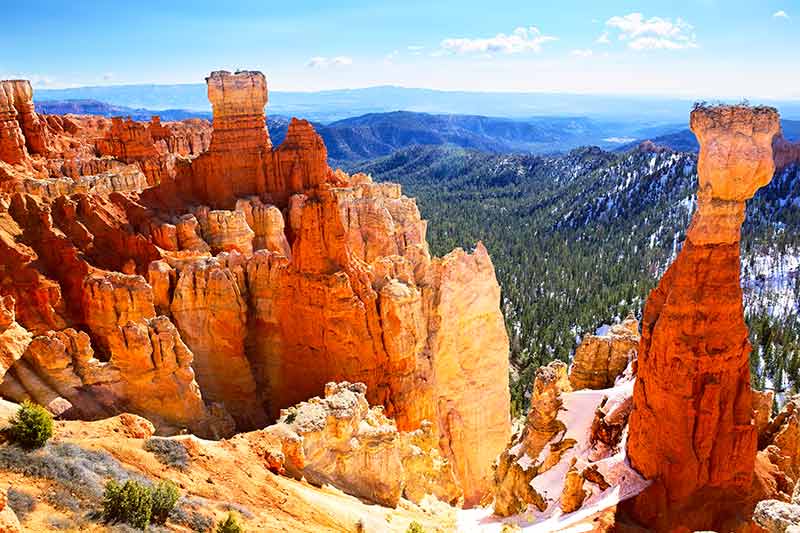
The spire-shaped rocks of Bryce Canyon’s Hoodoos are nature’s sculptures formed over thousands of years.
The four types of rocks of the Claron Formation – mudstone, limestone, siltstone and dolomite – erode at different rates causing these unique shapes.
The area around the Hoodoos is popular with hikers, stargazers and snowshoers in winter.
Bryce Canyon is part of the Colorado Plateau, a region that includes the Four Corners region straddling Utah, Colorado, Arizona and New Mexico.
Fine-grained sediment deposited over millions of years lithified into the sedimentary rock before being pushed upwards by tectonic activity.
Over time, these rocks were weathered, eroded and moulded into the layered columns we admire today.
The region’s weather, which includes below-freezing temperatures for 200 days of the year, allows rain and ice to play a part in creating the hoodoos.
Ice wedging occurs when freezing water within the rock expands and breaks the rock apart.
Bryce Canyon Country Visitor’s Bureau is at 55 South Main Street, Panguitch, Utah.
4- Big Bend
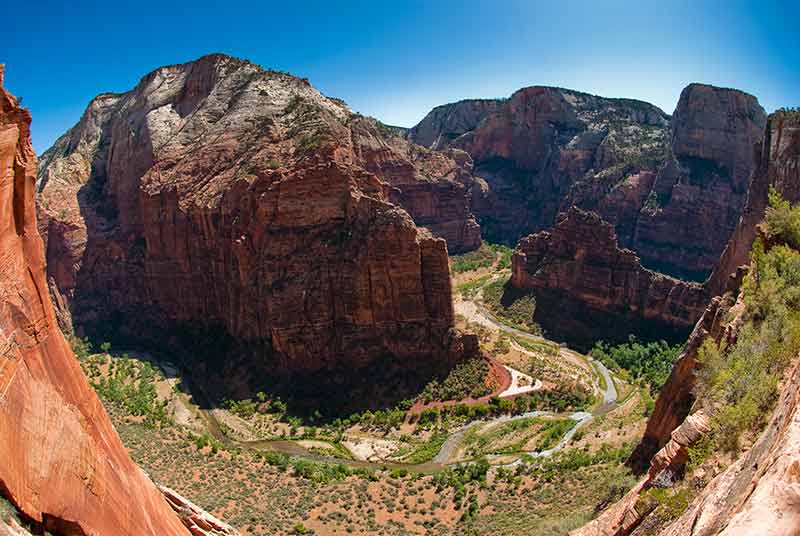
Big Bend is a famous turn along the Virgin River in Zion National Park that has graced many travel brochures.
The Zion Shuttle stops for visitors to walk down to the river to admire the view.
Zion National Park is home to the Zion Canyon and Virgin River Narrows.
The park offers fabulous hiking, canyoneering and climbing for outdoorsy types.
Zion National Park is at 1 Zion Park Blvd, State Route 9, Springdale.
5- Chimney Rock Pillar
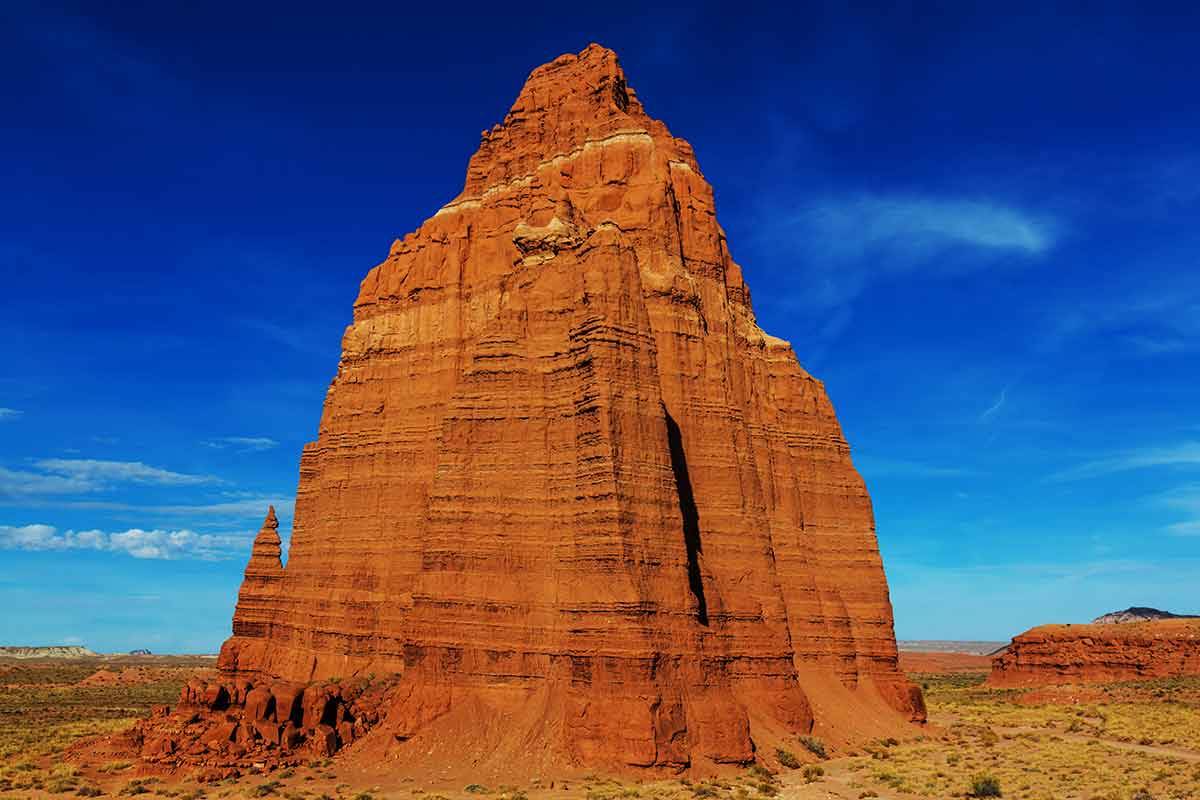
Chimney Rock Pillar is an impressive natural landmark in Capitol Reef National Park in the south-central desert of Utah.
This Utah landmark is a 6,420 ft (1,960-meter) elevation summit that towers over 300 feet (90 meters) above Highway 24.
The national park surrounds the Waterpocket Fold with sandstone layers, deep canyons, arches and other stunning rock formations.
It’s a 65 million-year-old warp in the earth’s crust.
Waterpocket Fold was created by the colliding continental plates forming the Rocky Mountains over millions of years.
The park has contrasting layers of earth and stone with coloured sandstone cliffs and gleaming white domes.
The park got its name because early settlers referred to the impassable ridges as “reefs”.
Chimney Rock is 2.5 miles (4km) northwest of the park’s visitor centre.
Also read:
- 20 USA Landmarks
- 23 Canada Landmarks
- 22 Ohio Landmarks
- 21 Arizona Landmarks
- 21 Minnesota Landmarks
- 21 Oregon Landmarks
- 21 Illinois Landmarks
- 21 Colorado Landmarks
- 21 Georgia Landmarks
- 21 Michigan Landmarks
- 23 Los Angeles Landmarks
- 21 Washington Landmarks
- 21 Maryland Landmarks
- 20 Manitoba Landmarks
- 20 Kansas Landmarks
- 21 New Mexico Landmarks
- 20 Idaho Landmarks
- 20 Montana Landmarks
- 20 Oklahoma Landmarks
- 21 Wisconsin Landmarks
- 20 Tennessee Landmarks
- 21 Iowa Landmarks
- 20 Alaska Landmarks
- 20 Miami Landmarks
- 21 West Virginia Landmarks
- 21 Kentucky Landmarks
- 20 Louisiana Landmarks
- 21 Arkansas Landmarks
- 20 Cincinnati Landmarks
- 20 San Antonio Landmarks
- 25 Indiana Landmarks
- 21 New York Landmarks
- 20 Texas Landmarks
- 21 Boston Landmarks
- 20 Florida Landmarks
- 20 Hawaii Landmarks
- 5 South Dakota Landmarks
- 21 Pennsylvania Landmarks
- 23 New Jersey Landmarks
- 21 Virginia Landmarks
- 21 North Carolina Landmarks
- 21 Utah Landmarks
- 21 Nevada Landmarks
- 20 Massachusetts Landmarks
- 20 Washington DC Landmarks
- 20 Vermont Landmarks
- 20 Nebraska Landmarks
- 20 North Dakota Landmarks
- 21 Missouri Landmarks
- 20 Rhode Island Landmarks
- 21 Maine Landmarks
- 21 Connecticut Landmarks
- 20 San Diego Landmarks
- 20 Landmarks In South Carolina
- 20 Mississippi Landmarks
- 20 Las Vegas Landmarks
- 20 Dallas Landmarks
- 20 Houston Landmarks
- 20 Seattle Landmarks
6- Coyote Gulch
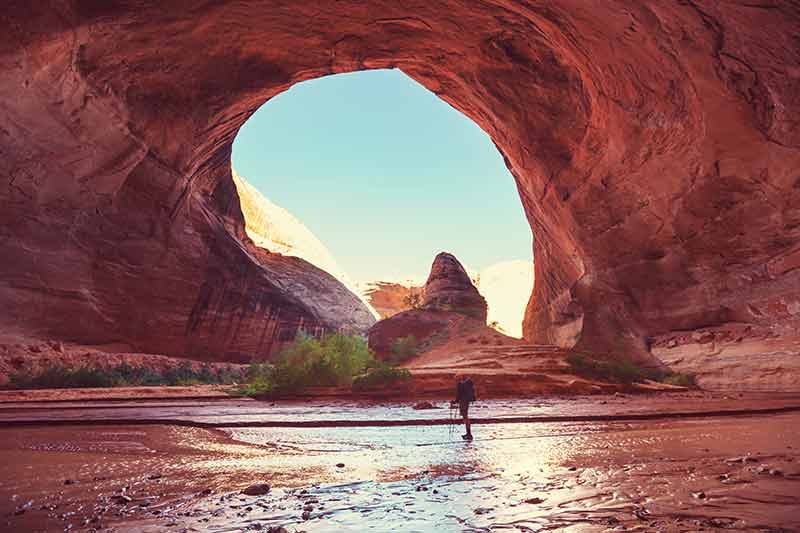
Coyote Gulch is a narrow, winding canyon that straddles the Grand Staircase-Escalante area and Glen Canyon National Recreation Area.
It connects with the Escalante River above Lake Powell.
The canyon has waterfalls, a natural bridge, two arches and is a popular place for hiking.
At the canyon’s mouth, high above the Escalante River, Stevens Arch is an impressive natural landmark in Utah with an opening of about 220 ft (67 m) wide.
Coyote Gulch is in the Glen Canyon National Recreation Area.
7- Factory Butte
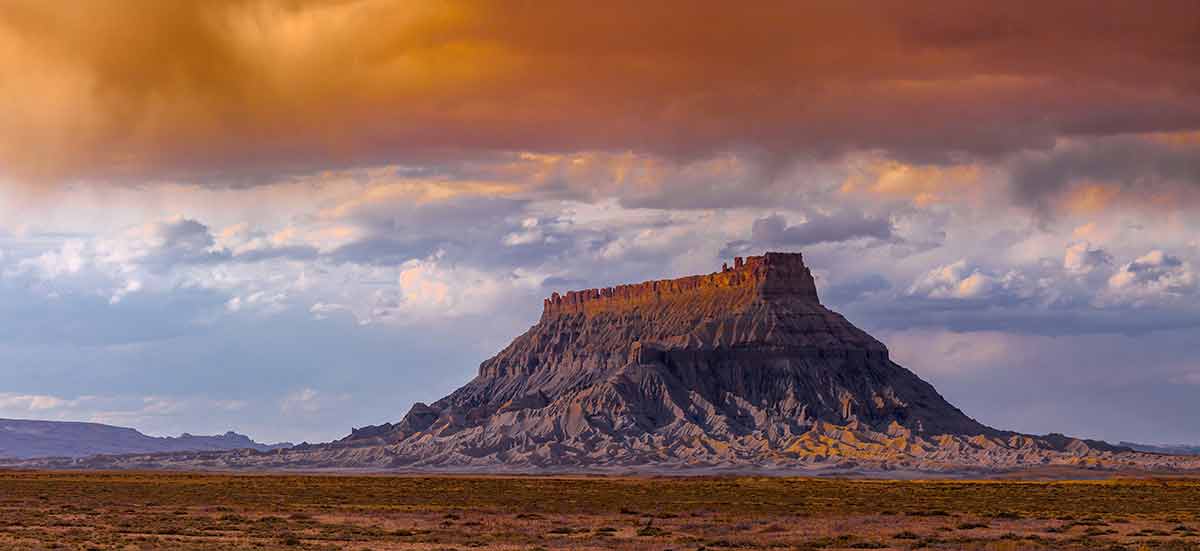
Factory Butte is a sandstone flat-topped peak that rises above the desert.
This eye-catching natural landmark of Utah is 6,302 ft and is part of the Upper Blue Hills in the state’s south.
Factory Butte is a beautiful place to see wildflowers in spring and photograph desert flowers and cacti.
Factory Butte is off Colamine Road, Highway 24, Torrey, Utah.
8- Flaming Gorge
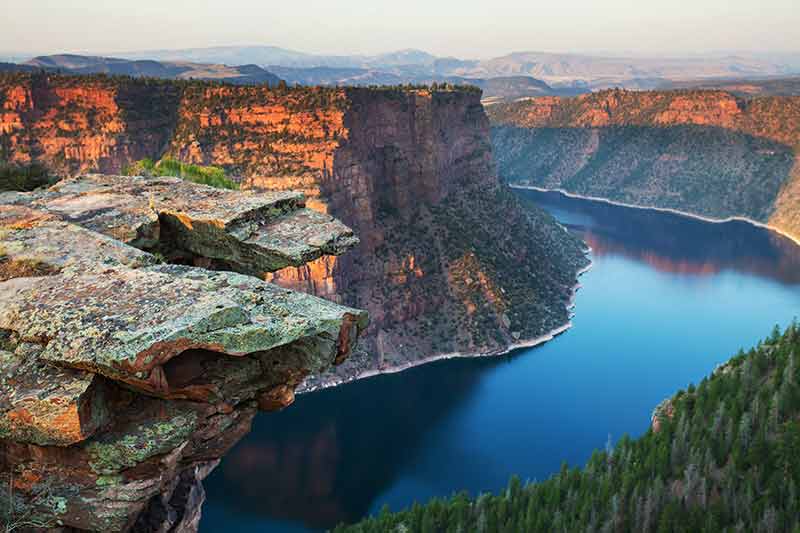
The Flaming Gorge straddles the southwest corner of Wyoming and Utah’s northeast corner.
The region is famous for hiking, climbing and fishing.
The Green River is the place to fish for Brown and Rainbow trout beneath Flaming Gorge Dam.
The canyon below the dam has soaring red rock walls and fantastic views.
Home to eagles and Big Horn sheep, it’s a beautiful river, while Flaming Gorge reservoir is a popular recreational destination for fishing, water skiing and boating.
9- Golden Cathedral
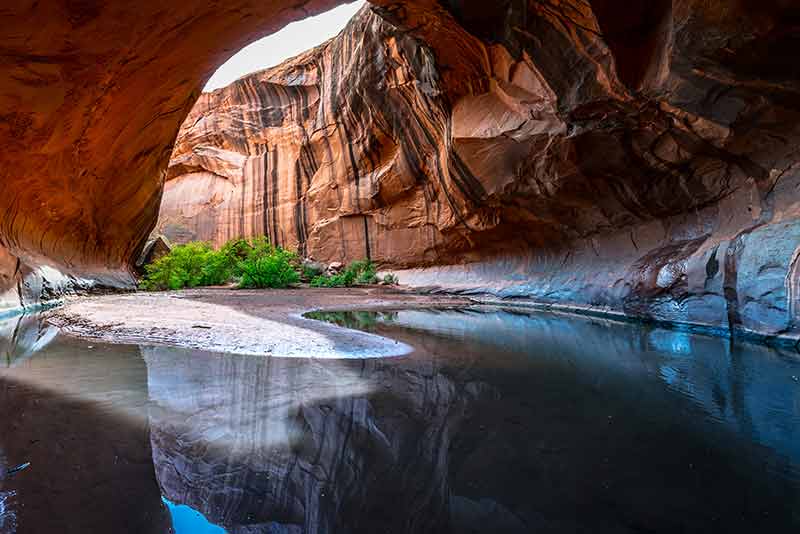
The dramatic light beaming down through the sandstone onto the water is an esoteric sight.
The Golden Cathedral is in the lower part of Neon Canyon and is a fantastic rock formation off the Escalante River.
The sandstone alcove has a famous triple pothole arch deep in Glen Canyon National Recreation Area wilderness.
Located in Neon Canyon, the trek to Golden Cathedral passes through 4.5 miles of desert terrain.
Neon Canyon is a long slot canyon that attracts canyoners attracted by its beauty and the canyon’s final rappel, an 80-foot free-hanging drop through the middle of The Golden Cathedral into the pool beneath it.
10- House of Fire
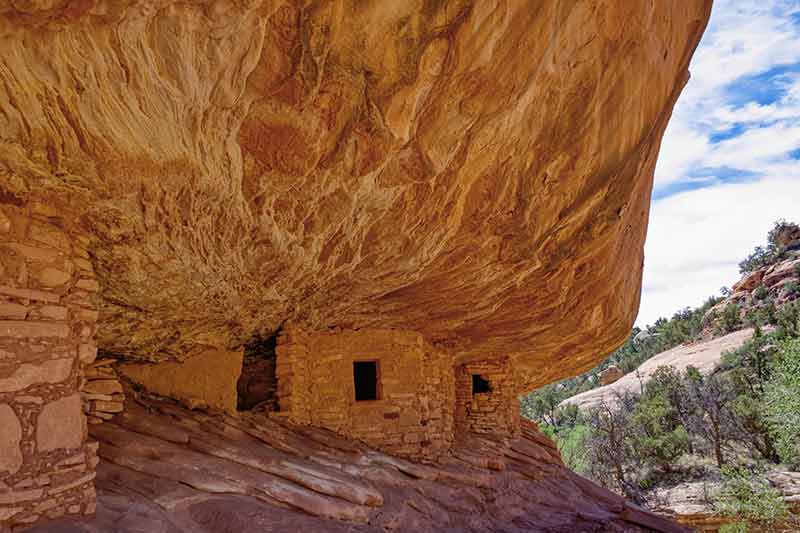
House on Fire is a ruin that sits under an overhanging rock that looks like it’s on fire at certain times of the day.
The historic landmark in Utah is part of the Bears Ears National Monument in San Juan County in the state’s southeast.
The historic site consists of five granaries constructed into the Cedar Mesa sandstone.
The hike through the canyon takes hikers back to when the Anasazi lived 800 years ago.
House of Fire is at the South Fork of Mule Canyon.
Discover more Famous World Landmarks:
- 25 Australian Landmarks
- 20 New Zealand Landmarks
- 20 African Landmarks
- 21 Egyptian Landmarks
- 20 Jordan Landmarks
- 10 Tasmanian Landmarks
- 20 Antarctica Landmarks
11- Hovenweep Castle
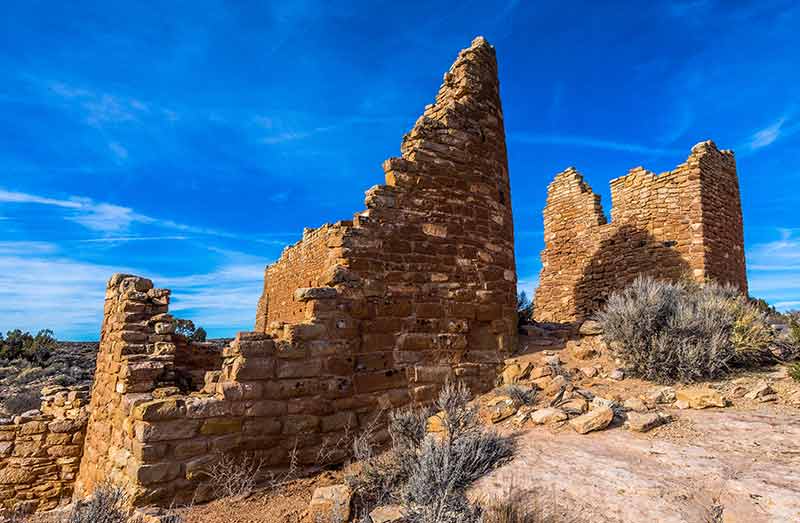
Hovenweep Castle has two D-shaped towers and thick stone walls sitting on a rim near the canyon’s head.
Although Archeologists named it a ‘castle’, no royalty lived here; farmers might have used it as a spiritual centre or dwelling.
The main entrance is a rectangular doorway that allows light to stream in during solstices and equinoxes.
The castle is in Hovenweep National Monument, which has six Ancestral Puebloan villages that were occupied up until the 14th century.
Hovenweep was granted ‘National Monument’ status in 1923 and became an International Dark Sky Park in 2014.
Hunters and gatherers occupied the Cajon Mesa region 10,000 years ago, and people were sheltered in natural caves.
Hovenweep Castle is one of the newest structures in the region, with most of the masonry structures built between AD 1230 and 1275.
12- Rainbow Bridge
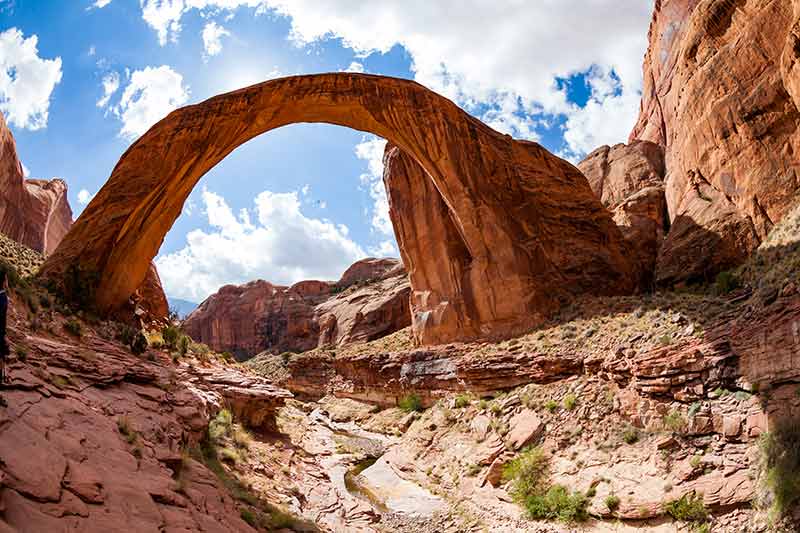
Rainbow Bridge is 290 ft (88 m) high and 270 ft (83 m) wide.
The Navajo consider it a symbol of their gods, responsible for life in the desert.
Water flowing from the Navajo Mountain to the Colorado River chiselled this natural bridge over thousands of years.
Before the flooding of Glen Canyon created Lake Powell through the Glen Canyon Dam, Rainbow Bridge was a hidden treasure that was ‘undiscovered’, but today, you can reach its base by boat, horseback, or hiking.
Hikers require a from the Navajo Nation.
Rainbow Bridge National Monument is at Forbidding Canyon, Lake Powell, Utah.
13- Reflection Canyon
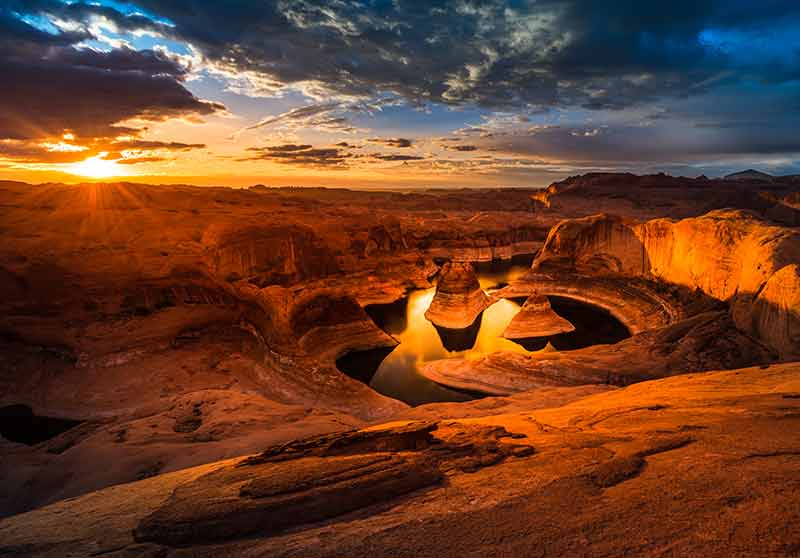
Reflection Canyon is an extension of Lake Powell and was pretty much unknown until National Geographic published Michael Melford’s canyon photos in 2006.
The canyon is a lesser-known location in Glen Canyon National Recreation Area and is a stunning sight similar to Arizona’s Horseshoe Bend.
The hike starts after a 50-mile drive down a dirt road, and you can hike to the canyon and back in a day, but it’s preferable to camp there to see the sunset and sunrise.
Reflection Canyon is a 24.5 km hike from Kanab and is suitable for experienced hikers.
14- Buckskin Gulch
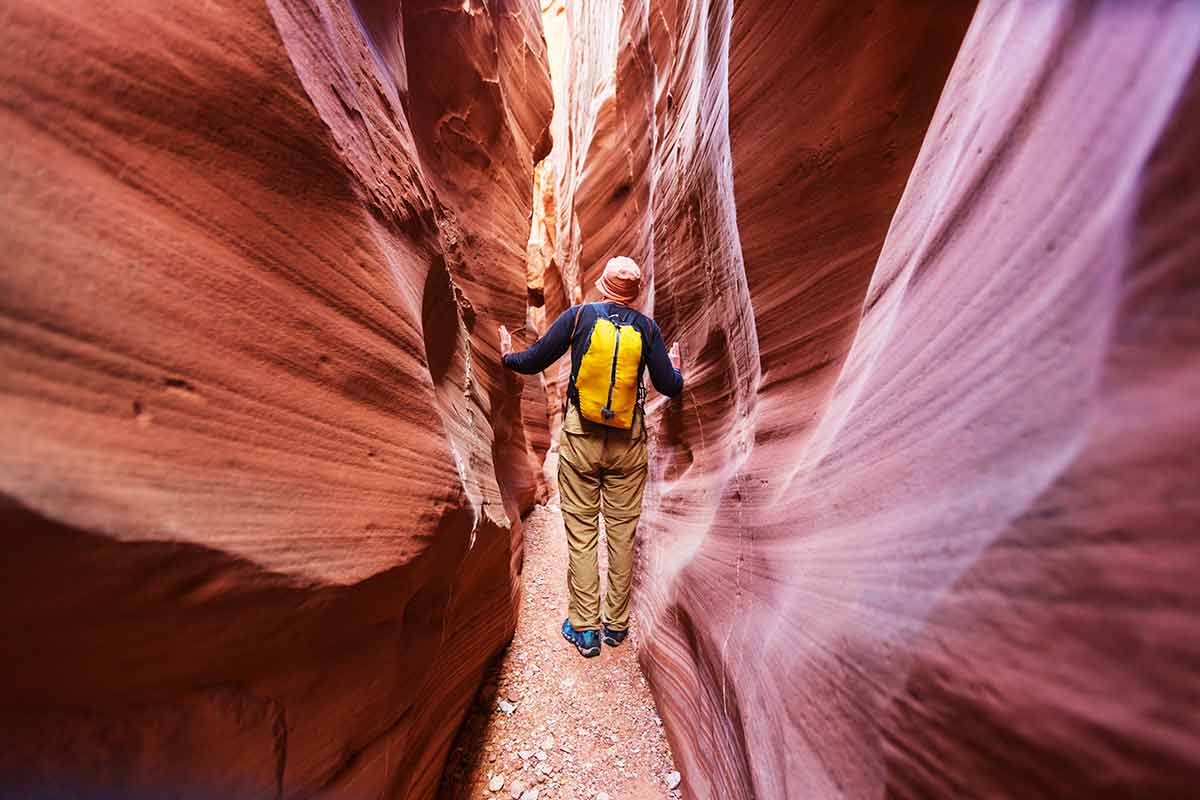
Buckskin Gulch is another natural landmark of Utah.
The slot canyon is a narrow gorge that runs for about 15 miles and is one of the world’s longest slot canyons.
The canyon is narrow and deep, with obstacles that make hiking this canyon challenging as you scramble over rocks and wade through potholes.
Buckskin Gulch is near Kanab, on the Utah/Arizona border, and fit hikers can explore it in a day.
One of the things Utah is famous for is its slot canyons, and many of them are easy to access.
Other slot canyons in Utah are Buckskin Gulch, Little Wild Horse Canyon, Burr Trail’s Singing Canyon, Peek-a-Boo, Spooky Gulch and Willis Creek Narrows.
Antelope Canyon is in Arizona, near the border of the two states.
Buckskin Gulch has two entrances (Buckskin Gulch Trailhead and Wire Pass Trailhead).
15- The Hoodoos in Goblin Valley State Park
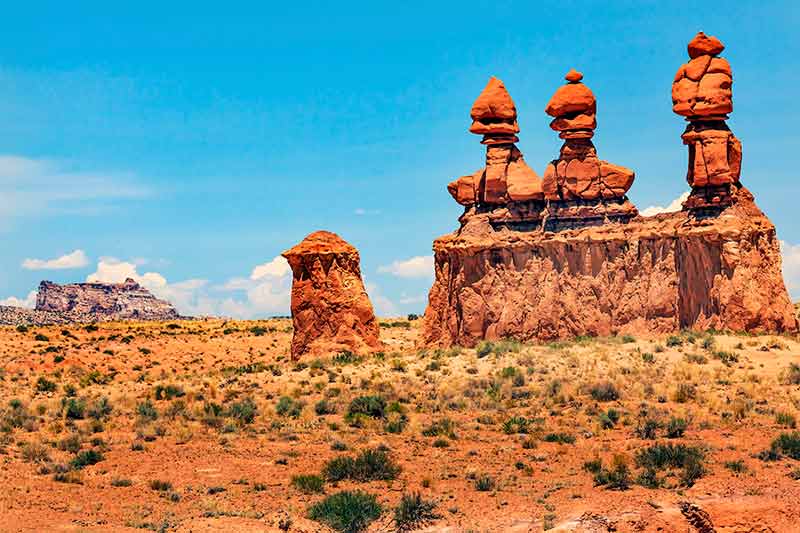
Goblin Valley State Park has thousands of ‘Hoodoos’ that look like fairy chimneys, mushrooms, goblins and castles.
Goblin Valley’s concentration of ‘Hoodoos’ makes it an enchanting place to explore, and the otherworldly scenery makes it an excellent backdrop to film fantasy movies like ‘Galaxy Quest’.
Goblin Valley Rd, Green River, UT
16- Virgin River
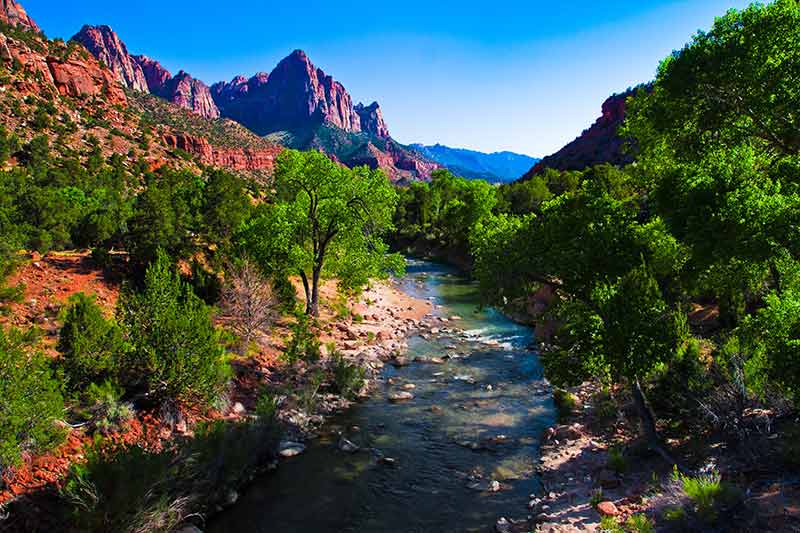
The Virgin River is 162 miles long and a tributary of the Colorado River carved through the red sandstone of Zion National Park to create stunning natural scenery.
“The Narrows”, which is on the North Fork of the river, is one of the top places to go hiking and the narrowest section of Zion Canyon.
The river meanders through the canyon past Willow and Cottonwood trees.
Foxes, rock squirrels, bighorn sheep, Mexican spotted owl and the Zion snail are some wildlife along the river.
17- Timpanogos Cave National Monument
Not far from Salt Lake City, Timpanogos Cave National Monument is a cave system in the Wasatch Mountain range.
Three caves are open for tours and offer viewings of helictites, stalactites and stalagmites.
Timpanogos Cave is at 2038 W. Alpine Loop Road, American Fork.
The Cosmic Navel is an enormous sandy pothole that is 200 ft wide. It’s so wide you could lay the Statue of Liberty down sideways.
The Navel has a lofty rock pedestal 33 ft high above the dune.
Grand Staircase Escalante National Monument covers 1 million acres in Utah.
Divided into three areas (Canyons of the Escalante, Grand Staircase and Kaiparowits Plateau), the region has spectacular cliffs, terraces, monoliths, arches, slot canyons and natural bridges.
It’s rich in Anasazi and Fremont cultures dating back to AD 950 to 1100 and rich with rock art, granaries and campsites.
Grand Staircase Escalante National Monument is at 745E Highway 89, Kanab.
19- Valley of the Gods
In Utah’s southeast, the Valley of the Gods is a scenic area packed with buttes and pinnacles.
The scenery is as breathtaking as Monument Valley’s and doesn’t have the tribal restrictions to visit.
The Valley of the Gods road runs between Highway 163 and Highway 261.
20- Monument Valley
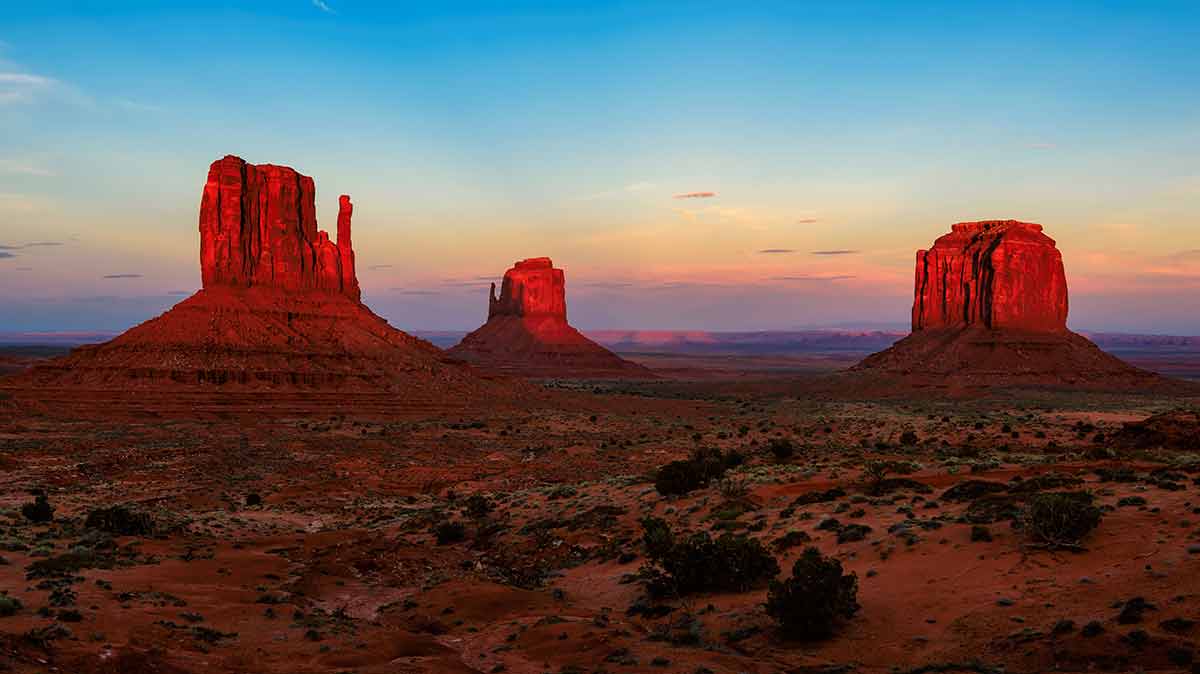
Monument Valley stretches over 91,000 acres of Navajo National Tribal land and has starred in many movies such as Easy Rider, Mission: Impossible II and Forrest Gump.
Although the area straddles Utah and Arizona, the entrance and many famous rock formations are in Utah.
Part of the Colorado Plateau, Monument Valley’s vivid red rocks is caused by the exposed iron oxide in the weathered siltstone, while the darker, blue-grey rocks are due to manganese oxide.
The valley has massive and impressive stone structures, such as the ‘Eye of the Sun’, two soaring buttes (known as the Mittens), Elephant Butte, the Rain God Mesa and The Three Sisters.
More than 100 ancient Ancestral Puebloan (or Anasazi) ruins date back to 1300 AD.
After the Anasazi abandoned the area, the Navajo occupied the valley and farmed the land for hundreds of years.
The Navajo saw the area as one enormous population in Monument Valley is about 100 people.
Monument Valley (Tse′ Bii’ Ndzisgaii) means white streaks amid the rocks or ‘clearing among the rocks’ in the Navajo language.
Also read:
- 21 Landmarks In Utah
- 20 Things To Do In Salt Lake City
- 18 National Parks In Utah
- 20 Beaches In Utah
- 20 Places To Go Glamping In Utah
- 20 Things To Do In Zion National Park
- 20 Things To Do In Monument Valley
- 20 Utah Cities
- Where To Stay In Salt Lake City
- 20 State Parks In Utah
- 20 Things To Do In Ogden
- 20 Things To Do In Logan
- 20 Things To Do In Moab
- Utah In Winter
- 15 Things Utah Is Famous For
- 20 Things To Do In Park City
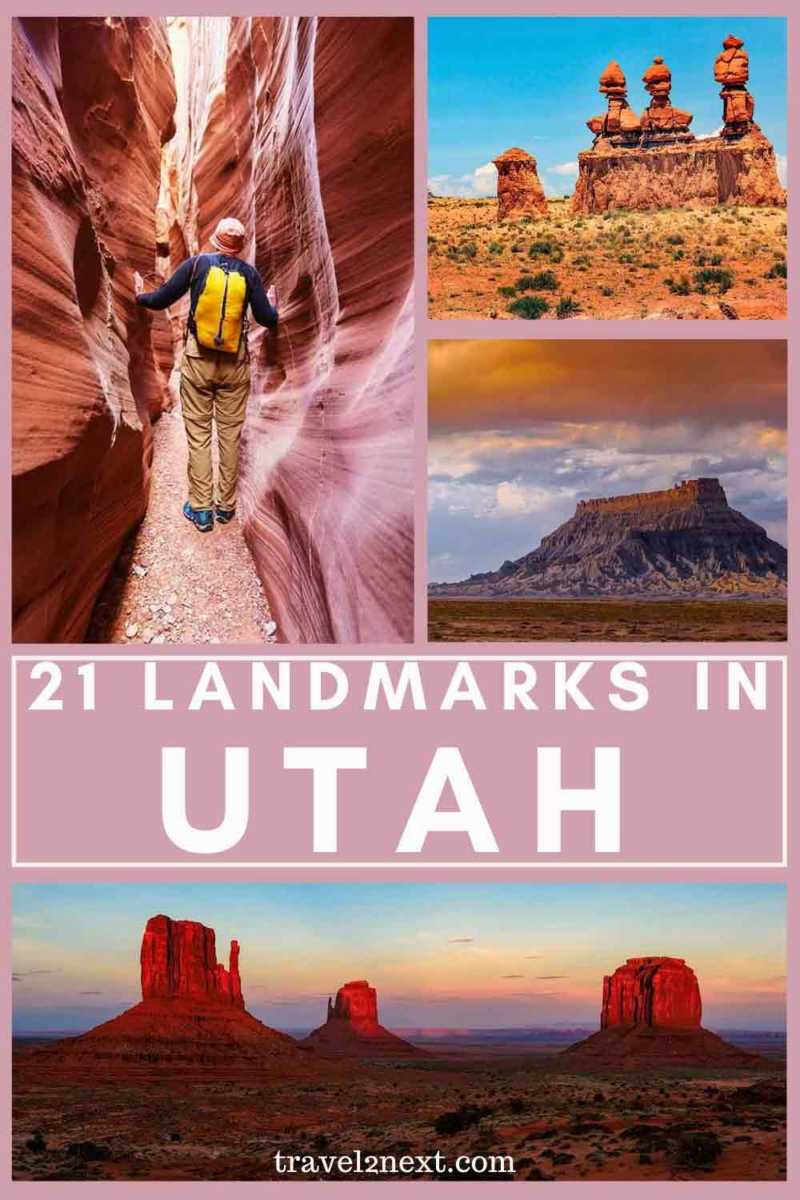
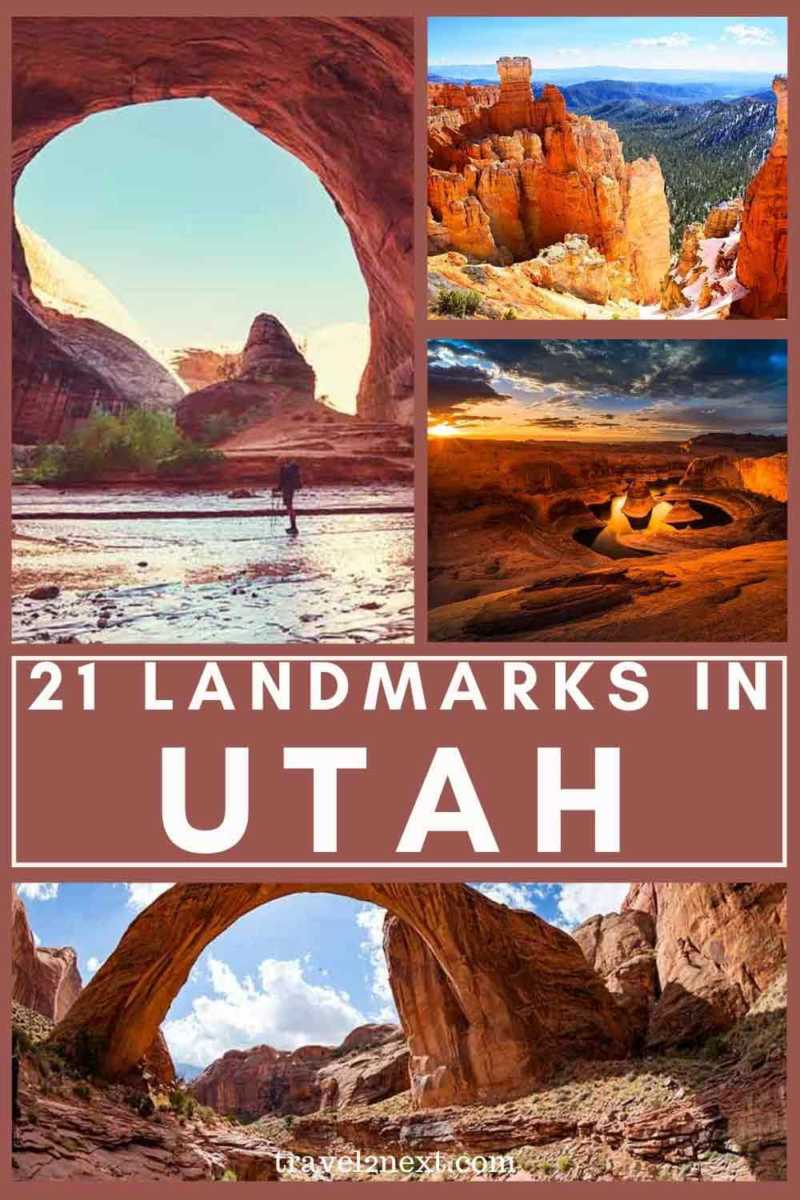
Plan Your Trip

Rent A Car – Find the best car rental rates at Discover Cars. They compare car hire companies to provide you with the best deal right now.

Find A Hotel – If you’re curious about this article and are looking for somewhere to stay, take a look at these amazing hotels.





